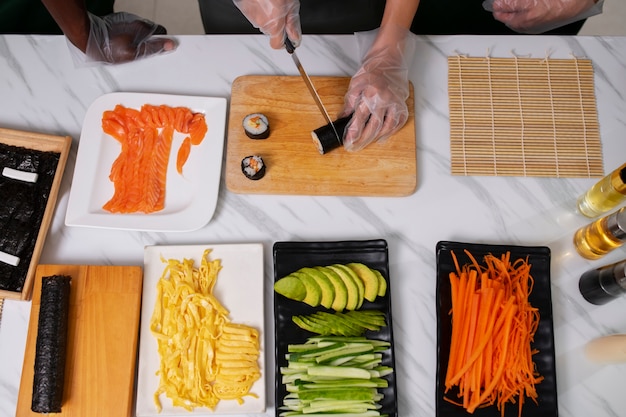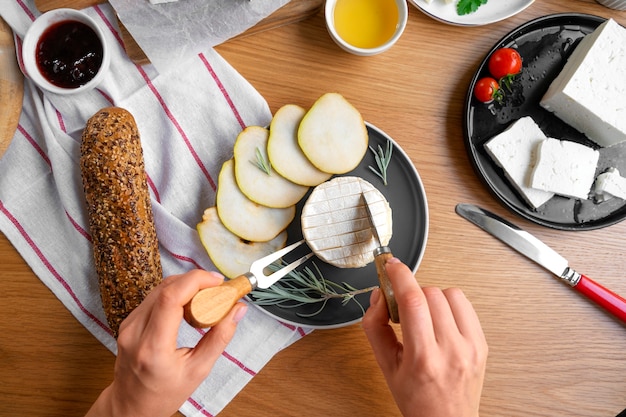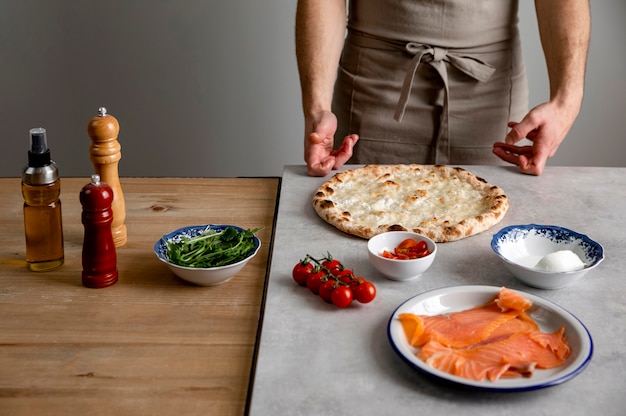There's nothing quite like a perfectly cooked new york strip steak. That rich, beefy flavour, the tender texture that melts in your mouth…it's a culinary experience that never gets old. But let’s be honest, getting that perfect doneness can feel like a gamble. One minute you're enjoying a succulent masterpiece, the next you’re staring at a dry and tough piece of meat. I’ve certainly been there, and I’ve learned a few things along the way that help me consistently nail that perfect level of doneness. So, grab a glass of your favourite beverage, settle in, and get ready for a culinary journey to mastering the art of cooking a New York strip steak. We’ll cover everything from selecting the best cut to nailing those beautiful sear marks, leaving you with a steak that's a true triumph.
(Part 1) Selecting Your Weapon: Choosing the Right New York Strip

The first step to a perfect steak is choosing the right cut. It’s like choosing the perfect weapon for battle – you wouldn’t go into a fight with just any old sword, would you? The same goes for a New York strip. You want something that’s got the right balance of marbling and thickness. Here’s what to look for:
The Marbling Game:
Marbling is the fat that’s woven throughout the meat. It’s the secret ingredient to a juicy and flavourful steak. Think of it like the veins in a beautiful marble sculpture. It adds richness and depth. When you’re looking for a New York strip, you want to see that marbling throughout the entire cut. Too much marbling can make your steak greasy, while too little can result in a dry, tough cut.
Thickness is Key:
The thickness of your steak is crucial for even cooking. A steak that’s at least 1 inch thick is ideal, preferably closer to 1 ?? inches. This allows for a more even distribution of heat, preventing the outside from becoming overcooked while the inside remains raw. I’ve made the mistake of trying to cook thin steaks before, and let me tell you, it’s not a pretty sight! They end up tough and chewy. Avoid that at all costs.
Bone-in or Boneless? The Great Debate:
Now, this is a matter of personal preference, but I’ll share my thoughts. Bone-in steaks tend to be juicier because the bone helps to retain heat while the steak cooks, acting like a little internal oven. They also look more impressive and add a rustic charm to the table. However, boneless steaks are easier to manage and cook more evenly. I tend to lean towards bone-in for that extra flavour and visual appeal. It just feels more satisfying! But if you're going for a more elegant presentation, boneless is a great option.
The Butcher Knows Best:
Don't be afraid to chat with your butcher. They’re the experts when it comes to meat, and they can help you choose the perfect cut for your needs and budget. They’ll be able to tell you the story behind each cut and guide you through different marbling levels and thickness options. Ask them for specific details about the origin of the meat, the aging process, and any special cuts they might have on hand. Remember, your butcher is your secret weapon to steak nirvana. Treat them well, and they’ll reward you with the best meat.
(Part 2) The Pre-Game Ritual: Preparing Your Steak

Now that you’ve got your weapon, it's time to prepare for the big game. This involves a few key steps that will ensure your steak is ready to shine. It's like warming up before a big race – you want to get your muscles ready for the action.
The Art of Resting:
The first rule of steak prep is: always, always, always let your steak come to room temperature before cooking. It’s like a warm-up for a marathon – letting the steak rest allows the internal temperature to rise gradually. This ensures a more even cook, especially for thicker cuts. Aim for 30-60 minutes on the counter, just enough time for it to get comfortable and relaxed. Don’t be tempted to rush it. Patience is key.
Dry Brining – A Quick and Easy Trick for Juiciness:
Dry brining is a simple but effective technique that helps to create a more flavorful and juicy steak. It involves salting the steak and letting it sit uncovered in the refrigerator for 1-2 hours. This process draws out moisture, which then gets reabsorbed by the steak, resulting in a more tender and flavorful final product. You don’t need anything fancy – just a generous sprinkle of salt and a little bit of time. The salt draws out the moisture, creating a delicious crust. It’s a simple trick that makes a big difference.
A Little Seasoning Magic:
Keep seasoning simple. Salt and freshly ground black pepper are all you really need. If you want to get fancy, you can add other spices like garlic powder, onion powder, or paprika. But remember, less is more. You don't want to overwhelm the natural flavor of the steak. The key here is to enhance the natural flavour, not drown it out. You want to savour every bite.
(Part 3) The Showstopper: Cooking Your New York Strip Steak

Alright, the moment of truth is here! It's time to bring out the big guns – your trusty pan, grill, or oven. Here’s a breakdown of each method:
cast iron pan: The Classic Choice:
Cast iron pans are a classic choice for searing steaks. They distribute heat evenly and retain it well, resulting in a beautiful crust and even cooking. Here’s how to make it happen:
- Heat the pan over high heat. You want it smoking hot, like a volcano about to erupt!
- Add a tablespoon or two of oil. I prefer a neutral oil like canola or vegetable oil.
- Place the steak in the pan and sear for 2-3 minutes per side. Don't move the steak around too much; let it form a nice crust. You're basically giving it a hot bath, so let it soak in the heat.
- Reduce the heat to medium and cook for another 2-3 minutes per side for medium-rare, or adjust the time depending on your desired doneness. Let it cook, relax, and soak up the heat.
- Remove the steak from the pan and let it rest for 5-10 minutes before slicing and serving. This is important, because it allows the juices to redistribute throughout the steak, resulting in a more tender and flavorful cut.
The Grill – The Backyard Masterpiece:
Grilling is another popular method for cooking steaks. It adds a smoky flavour and creates beautiful grill marks. Get your grill blazing hot and follow these tips:
- Clean your grill grates well. You want a pristine canvas to create your masterpiece.
- Preheat the grill to high heat. You want those flames licking at your steak, ready to char and sear.
- Oil the grill grates lightly. This prevents the steak from sticking and helps to create those beautiful grill marks.
- Place the steak on the grill and cook for 2-3 minutes per side. You're aiming for a beautiful crust, a sign of a steak that’s been given a good grilling session.
- Reduce the heat to medium and continue cooking for another 2-3 minutes per side for medium-rare, or adjust the time depending on your desired doneness.
- Remove the steak from the grill and let it rest for 5-10 minutes before slicing and serving.
Oven-Roasted – A Controlled Approach:
For a more hands-off approach, oven-roasting is a great option. It allows for even cooking and can be done in advance. Here's what you need to know:
- Preheat your oven to 400°F (200°C). Get that oven nice and hot.
- Place the steak on a baking sheet lined with parchment paper. This makes for easy clean-up and prevents the steak from sticking.
- Roast the steak for 8-10 minutes per side for medium-rare, or adjust the time depending on your desired doneness. Let the oven do its magic.
- Remove the steak from the oven and let it rest for 5-10 minutes before slicing and serving.
(Part 4) The Internal Temperature Game: Knowing Your Doneness
Now, let's talk about doneness. This is the moment of truth, the moment you decide how much heat your steak will embrace. It's a personal preference, but there are some general guidelines to follow.
Doneness Guide:
Here is a handy table to show you the internal temperature and doneness of your steak:
| Doneness | Internal Temperature (°F) | Internal Temperature (°C) |
|---|---|---|
| Rare | 125-130 | 52-54 |
| Medium-Rare | 130-135 | 54-57 |
| Medium | 140-145 | 60-63 |
| Medium-Well | 150-155 | 65-68 |
| Well-Done | 160 | 71 |
Remember, these are just guidelines. You may prefer your steak a bit more done or less done. It all comes down to personal preference.
The Touch Test – A Little Cheat:
If you don't have a meat thermometer, you can use the touch test to estimate the doneness. Press the center of the steak with your finger:
- Rare: Soft and spongy
- Medium-Rare: Slightly firm, like the pad of your thumb
- Medium: Firm, like the tip of your nose
- Well-Done: Very firm, like your forehead
This is a rough estimate, but it can be helpful if you’re in a pinch.
(Part 5) The Final Touch: Resting and Slicing
After your steak is cooked, resist the urge to slice it right away. It's important to let it rest for 5-10 minutes before slicing. This allows the juices to redistribute throughout the steak, resulting in a more tender and flavorful cut. Think of it as a chance to catch your breath and let those flavours settle.
The Art of Slicing:
Once the steak is rested, slice it against the grain. This means slicing perpendicular to the muscle fibers, which will make the steak easier to chew and more tender. Imagine cutting across the lines of a beautifully drawn tablecloth, cutting through those fibers. It’s like cutting through a soft, velvety fabric.
(Part 6) The Sidekick: Pairing Your Steak
Now, let's talk sides! A good steak deserves a good sidekick, something to complement its rich flavours and enhance the dining experience. Here are some of my personal favourites:
- Roasted Vegetables: They add a burst of color and freshness. I love roasted asparagus, Brussels sprouts, and broccoli. The roasting process brings out the sweetness of the vegetables and creates a delicious contrast to the savory steak.
- mashed potatoes: A classic pairing. The creamy texture of mashed potatoes complements the rich flavour of the steak. You can jazz them up by adding herbs or cheese.
- grilled corn on the Cob: A smoky and sweet side. The charring from the grill adds a nice depth of flavor and complements the steak's savory notes.
- Garlic Bread: A simple but satisfying side. The garlic flavour complements the steak's savory notes, and the bread is perfect for soaking up the delicious juices.
- Green Salad: A refreshing and healthy option. A simple salad with a light vinaigrette is the perfect way to balance the richness of the steak.
Ultimately, the best side dishes are the ones that you enjoy the most. So don’t be afraid to experiment and find what works best for you.
(Part 7) The Secret Sauce: Sauces and Condiments
While a great steak doesn't need much fuss, adding a sauce or condiment can elevate the experience to another level. Think of it as an extra layer of flavour, a finishing touch to your masterpiece.
The Classics:
- Béarnaise Sauce: A classic French sauce made with egg yolks, butter, and tarragon. It adds a rich and creamy flavour to the steak.
- Red Wine Sauce: A simple but delicious sauce made with red wine, shallots, and herbs. It's perfect for adding a touch of acidity and depth to the steak.
- Peppercorn Sauce: A bold and flavorful sauce made with cracked black peppercorns, butter, and cream. It adds a spicy kick to the steak.
- Horseradish Cream: A refreshing and tangy sauce made with horseradish, cream, and sour cream. It's perfect for cutting through the richness of the steak.
The Simple Touches:
- Salt and Pepper: The simplest and often the most effective. Freshly ground black pepper adds a nice bite to the steak.
- Garlic Butter: A delicious and easy sauce made with butter, garlic, and parsley. It adds a rich and savory flavour to the steak.
(Part 8) The Finishing Touches: Presentation and Serving
Now that your steak is cooked to perfection, it's time to put on the finishing touches. Presentation is everything. You want to make your steak look as good as it tastes.
Creating a Visual Feast:
- Slice the steak neatly: Use a sharp knife to slice the steak evenly.
- Arrange the steak on a serving platter: Use a platter that complements the steak's color. I like to use a dark wooden board, as it adds a touch of rustic elegance.
- Add your side dishes: Arrange the side dishes around the steak to create a balanced and visually appealing presentation.
- Garnish with herbs: A sprig of rosemary or thyme adds a touch of freshness and visual appeal.
Serving with Style:
Serve the steak immediately. It's best enjoyed hot and fresh.
FAQs (Frequently Asked Questions)
1. How do I know if my steak is cooked to my desired doneness?
The best way to determine the doneness of your steak is to use a meat thermometer. Insert the thermometer into the thickest part of the steak and make sure it's not touching bone. The internal temperature should correspond to your desired level of doneness. If you don't have a meat thermometer, you can use the touch test, but keep in mind that it’s a rough estimate.
2. What happens if I overcook my steak?
If you overcook your steak, it will become tough and dry. The muscle fibers will tighten up, and the juices will be lost. You can avoid this by using a meat thermometer and paying attention to the cooking time. If you do overcook your steak, there's not much you can do to salvage it, but you can always try to make a delicious steak sandwich out of it.
3. Can I cook a New York strip steak in the microwave?
I wouldn't recommend cooking a New York strip steak in the microwave. The high heat will dry out the steak and prevent you from getting that delicious sear. It’s best to stick to traditional cooking methods like pan-searing, grilling, or oven-roasting.
4. How long should I rest my steak before slicing?
Resting your steak for 5-10 minutes before slicing allows the juices to redistribute throughout the meat, resulting in a more tender and flavorful cut. It's an essential step in the cooking process, so don't skip it!
5. What is the best way to store leftover steak?
Store leftover steak in an airtight container in the refrigerator for up to 3-4 days. You can reheat it in the oven or microwave, or use it in other dishes like salads or sandwiches. Just make sure to bring it to room temperature before slicing and serving.
There you have it, folks! Now, you’re well on your way to becoming a steak master. Don’t be afraid to experiment and find what works best for you. Remember, cooking is about creativity and having fun in the kitchen. So, get those knives sharpened, crank up the heat, and enjoy the journey to deliciousness!
Everyone is watching

How to Cook Frozen Lobster Tails Perfectly: A Step-by-Step Guide
RecipesLobster. Just the word conjures up images of lavish meals, special occasions, and a taste of luxury. But let's...

Pigs in a Blanket Cooking Time: How Long to Bake for Perfect Results
RecipesAh, pigs in a blanket. Just the name conjures up images of those delightful little parcels of crispy pastry en...

Pork Fillet Cooking Time: How Long to Cook It Perfectly
RecipesPork fillet, or tenderloin as it's sometimes called, is a real favourite in our house. It's so versatile, and...

The Ultimate Guide to Cooking Delicious Frankfurters
RecipesLet's face it, we all love a good frankfurter. It's a classic, simple, and always satisfying. But let's be rea...

Wolf Meat Recipes: A Guide to Cooking Wild Game
RecipesLet's be honest, you don't see wolf meat at your local butcher shop every day. It's a bit of a wild card, but ...
